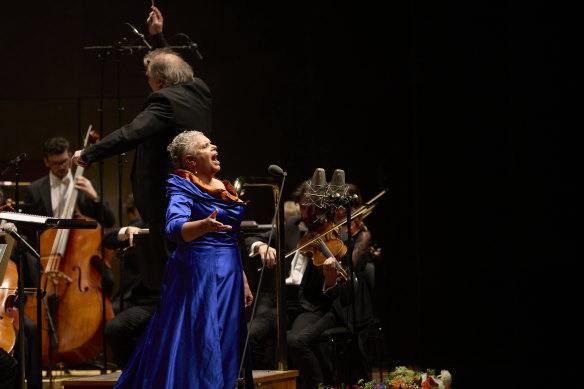
“We really do attempt to make these works in a way that’s not overbearing or confronting,” says Supple, who specialises in large-scale public events such as this. “We want them to emerge out of the background noise of the city and then recede again. It’s about encouraging this kind of intentional listening, deep listening, so people have this moment of pause when they can take stock of their environment.”
To achieve that takes a lot of planning. “You can’t just throw a set of speakers on top of a building and hope for the best,” Cheetham Fraillon explains.

Deborah Cheetham Fraillon.Credit: Laura Manariti
To realise the work requires a massive sound system of 12 amplifiers connected to 32 speakers mounted on top of skyscrapers lining the river. All of that infrastructure will be invisible from the streets, and Supple hopes people’s unexpected encounters with the work will leave a lasting impression.
“That’s one of the things that festivals are really great at, bringing people together and exposing these cultural moments so that they see their cities in a different light. If you can create those lasting memories for people where they’re able to reimagine their city or fall in love with their city again, you’ve done a really successful job.”
You can’t step into the same river twice, so it’s fitting that every performance of The Rivers Sing is unique. Each day Scullin assembles a new composition from more than 1200 sound files. Cheetham Fraillon says that its nature as a large-scale public work also means that factors as diverse as the prevailing winds, construction noise and the mood of the individual listener will also shape the experience.
It might be a challenge to compose work when its reception depends on so many variables, but Cheetham Fraillon says: “I’m working with the most reliable material you could possibly ever hope for, and that is the story of the river. It was a place of gathering, like a knowledge highway First Nations people would travel, the Wurundjeri from the north, the Boonwurrung from the south.”
The Rivers Sing premiered as part of Rising in 2021, just as Melbourne fell into a lockdown that would ultimately force the cancellation of most of the festival. The sound work did go ahead, but its ethereal melodies fell on a city mostly emptied of people. “Never before, I think, had the city borne that kind of silence,” says Cheetham Fraillon.
Loading
The meaning of the work was transformed by those vacant streets. “It was like the city had something to say. It was like the city was crying when the voices rang through,” she adds.
Supple is excited that this incarnation of the work will be heard by a repopulated city. No two listeners will hear the same work, however.
“You’re standing inside of this massive cluster chord where all of the different notes are coming from different positions and the configuration will change depending on where you stand,” he says.
Wherever they find themselves, Supple hopes that The Rivers Sing encourages listeners to reconsider the importance of Melbourne’s greatest liquid assets, “turning towards the waterways and understanding that these sentinels of the landscape are defining features and can be used to change perception of what the city is”.
The Rivers Sing is at Rising from June 1-16.
The Booklist is a weekly newsletter for book lovers from books editor Jason Steger. Get it every Friday.



























